Retrieval of Dissolved Organic Carbon Storage in Plateau Lakes Based on Remote Sensing and Analysis of Driving Factors: A Case Study of Lake Dianchi
Abstract
1. Introduction
2. Materials and Methods
2.1. Study Area
2.2. DOC Sampling and Remote Sensing Image Acquisition
2.3. Remote Sensing Retrieval Methods for DOC Storage
2.3.1. Surface DOC Concentration Retrieval Model
2.3.2. DOC Storage Retrieval Model
- Construct a DOCc retrieval model based on remote sensing image spectral data and measured surface concentration data.
- Analyze and determine the optimal fitting function type (Gaussian, exponential, or power function) for vertical DOCc changes in Dianchi based on the characteristics of measured vertical DOCc data. Calibrate the parameters of the fitting function, initializing the parameters based on different surface DOCc.
- Determine the depth of the well-mixed layer in Dianchi based on assumption (2). Use the fitting function to calculate DOCs above the mixed layer depth, and use uniform integration to calculate DOCs from the mixed layer depth to the bottom. The final DOCs for a single section is the sum of the DOCs from these two parts.
- The lake depth is obtained from lake elevation data, which comes from the literature [34]. Based on assumption (3), calculate measured DOCs from measured vertical DOCc to explore the relationship between DOCs at different depths and surface DOCc, and use lake depth to determine the parameters in Formulas (2)–(4).
- Use the surface DOCc retrieved in Step One, lake depth data from Step Four, and the calibrated formulas to retrieve DOCs in Dianchi.
2.3.3. Model Accuracy Evaluation
2.4. Other Data Sources and Processing Methods
3. Results
3.1. Surface DOC Concentration Retrieval for Lakes
3.2. Vertical Profile DOC Concentration Variation Characteristics in Dianchi
3.3. DOC Storage Estimation for Dianchi
3.4. Spatiotemporal Variation Characteristics of DOC Storage
4. Discussion
5. Conclusions
- (1)
- The vertical DOCc variation in Dianchi can be accurately modeled using a Gaussian function, and concentration changes below a depth of 2 m can be considered uniform. DOCs at different depths show a linear relationship with surface DOCc. The retrieval method for DOCs based on result-oriented conditions demonstrates good accuracy.
- (2)
- The spatial distribution of DOCs in Dianchi from 2000 to 2023 shows a pattern of “high in the center and low around the edges”. The temporal variation of DOCs follows a “high in summer and autumn, low in spring and winter, but with significant winter increases eventually exceeding summer levels” trend.
- (3)
- Annual average DOCs in Dianchi are significantly positively correlated with precipitation and significantly negatively correlated with wind speed, NAPI, and forest land. On a monthly scale, DOCs are significantly positively correlated with monthly mean water temperature. Precipitation and forest land are identified as the most important natural and anthropogenic factors affecting DOCs, respectively.
Author Contributions
Funding
Data Availability Statement
Conflicts of Interest
References
- Stets, E.G.; Striegl, R.G.; Aiken, G.R.; Rosenberry, D.O.; Winter, T.C. Hydrologic support of carbon dioxide flux revealed by whole-lake carbon budgets. J. Geophys. Res. Biogeosci. 2009, 114, G000783. [Google Scholar] [CrossRef]
- Liu, D.; Sun, Z.; Shen, M.; Tian, L.; Yu, S.; Jiang, X.; Duan, H. Three-dimensional observations of particulate organic carbon in shallow eutrophic lakes from space. Water Res. 2023, 229, 119519. [Google Scholar] [CrossRef]
- Harkort, L.; Duan, Z. Estimation of dissolved organic carbon from inland waters at a large scale using satellite data and machine learning methods. Water Res. 2023, 229, 119478. [Google Scholar] [CrossRef]
- Liu, D.; Du, Y.; Yu, S.; Luo, J.; Duan, H. Human activities determine quantity and composition of dissolved organic matter in lakes along the Yangtze River. Water Res. 2020, 168, 115132. [Google Scholar] [CrossRef]
- Liu, D.; Yu, S.; Xiao, Q.; Qi, T.; Duan, H. Satellite estimation of dissolved organic carbon in eutrophic Lake, Taihu, China. Remote Sens. Environ. 2021, 264, 112572. [Google Scholar] [CrossRef]
- Cardille, J.A.; Leguet, J.-B.; del Giorgio, P. Remote sensing of lake CDOM using noncontemporaneous field data. Can. J. Remote Sens. 2013, 39, 118–126. [Google Scholar] [CrossRef]
- Chen, J.; Zhu, W.; Tian, Y.Q.; Yu, Q. Monitoring dissolved organic carbon by combining, Landsat-8.; Sentinel-2 satellites: Case study in Saginaw River estuary Lake Huron. Sci. Total Environ. 2020, 718, 137374. [Google Scholar] [CrossRef]
- Pan, X.; Wong, G.T. An improved algorithm for remotely sensing marine dissolved organic carbon: Climatology in the northern South China Sea shelf-sea and adjacent waters. Deep Sea Res. Part II Top. Stud. Oceanogr. 2015, 117, 131–142. [Google Scholar] [CrossRef]
- Qu, X.; Xie, L.; Lin, Y.; Bai, Y.; Zhu, Y.; Xie, F.; Giesy, J.P.; Wu, F. Quantitative qualitative characteristics of dissolved organic matter from eight dominant aquatic macrophytes in Lake, Dianchi, China. Environ. Sci. Pollut. Res. 2013, 20, 7413–7423. [Google Scholar] [CrossRef]
- Qi, L.; Hu, C.; Duan, H.; Zhang, Y.; Ma, R. Influence of Particle Composition on Remote Sensing Reflectance MERIS Maximum Chlorophyll Index Algorithm: Examples from Taihu Lake Chaohu Lake. IEEE Geosci. Remote Sens. Lett. 2015, 12, 1170–1174. [Google Scholar]
- Kong, H.; Lu, Y.; Dong, X.; Zeng, S. Quantification of the Coordination Degree between Dianchi Lake Protection Watershed Social-Economic Development: A Scenario-Based Analysis. Sustainability 2021, 13, 116. [Google Scholar] [CrossRef]
- Duan, Z.; Wang, M.; Chang, X.; Gao, W. Response of river-lake hydrologic regimes to local climate change in the Yunnan-Guizhou Plateau region, China. Reg. Environ. Change 2020, 20, 122. [Google Scholar] [CrossRef]
- Zhang, Y.; Loiselle, S.; Shi, K.; Han, T.; Zhang, M.; Hu, M.; Jing, Y.; Lai, L.; Zhan, P. Wind Effects for Floating Algae Dynamics in Eutrophic Lakes. Remote Sens. 2021, 13, 800. [Google Scholar] [CrossRef]
- Xue, K.; Zhang, Y.; Duan, H.; Ma, R.; Loiselle, S.; Zhang, M. A Remote Sensing Approach to Estimate Vertical Profile Classes of Phytoplankton in a Eutrophic Lake. Remote Sens. 2015, 7, 14403–14427. [Google Scholar] [CrossRef]
- Xue, K.; Zhang, Y.; Ma, R.; Duan, H. An approach to correct the effects of phytoplankton vertical nonuniform distribution on remote sensing reflectance of cyanobacterial bloom waters. Limnol. Oceanogr. Methods 2017, 15, 302–319. [Google Scholar] [CrossRef]
- Bi, S.; Li, Y.; Lyu, H.; Mu, M.; Xu, J.; Lei, S.; Miao, S.; Hong, T.; Zhou, L. Quantifying Spatiotemporal Dynamics of the Column-Integrated Algal Biomass in Nonbloom Conditions Based on OLCI Data: ACase Study of Lake Dianchi China. IEEE Trans. Geosci. Remote Sens. 2019, 57, 7447–7459. [Google Scholar] [CrossRef]
- Qi, L.; Hu, C.; Visser, P.M.; Ma, R. Diurnal changes of cyanobacteria blooms in Taihu Lake as derived from GOCI observations. Limnol. Oceanogr. 2018, 63, 1711–1726. [Google Scholar] [CrossRef]
- Uitz, J.; Claustre, H.; Morel, A.; Hooker, S.B. Vertical distribution of phytoplankton communities in open ocean: An assessment based on surface chlorophyll. J. Geophys. Res. Ocean. 2006, 111, C08005. [Google Scholar] [CrossRef]
- Ardyna, M.; Babin, M.; Gosselin, M.; Devred, E.; Bélanger, S.; Matsuoka, A.; Tremblay, J. Parameterization of vertical chlorophyll a in the Arctic Ocean: Impact of the subsurface chlorophyll maximum on regional seasonal annual primary production estimates. Biogeosciences 2013, 10, 4383–4404. [Google Scholar] [CrossRef]
- Dongshao, W.; Min, C.; Zhongzhao, D.; Yuan, Z.; Wei, G. The variation and source-sink effect of total phosphorus flux input and output of Lake Dianchi during 2001–2018. J. Lake Sci. 2023, 35, 1306–1319. [Google Scholar] [CrossRef]
- Kediao, H.; Wei, G.; Changqun, D.; Yuangao, Z.; Ying, P.; Chang’E, L.; Wei, Z.; Guiying, Y. Water level variation and its driving factors in Lake Dianchi, Fuxian and Yangzong during 1988–2015. J. Lake Sci. 2019, 31, 1379–1390. [Google Scholar] [CrossRef]
- Duan, Z.; Gao, W.; Cheng, G.; Zhang, Y.; Chang, X. Warming surface Lake heatwaves as key drivers to harmful algal Blooms: Acase study of Lake Dianchi China. J. Hydrol. 2024, 632, 130971. [Google Scholar] [CrossRef]
- Wu, D.; Cao, M.; Gao, W.; Duan, Z.; Zhang, Y. Simulating critical nutrient loadings of regime shift in the shallow plateau Lake Dianchi. Ecol. Model. 2024, 491, 110689. [Google Scholar] [CrossRef]
- Ma, J.; He, F.; Qi, T.; Sun, Z.; Shen, M.; Cao, Z.; Meng, D.; Duan, H.; Luo, J. Thirty-Four-Year Record (1987–2021) of the Spatiotemporal Dynamics of Algal Blooms in Lake Dianchi from Multi-Source Remote Sensing Insights. Remote Sens. 2022, 14, 4000. [Google Scholar] [CrossRef]
- Du, Y.; Zhang, Y.; Ling, F.; Wang, Q.; Li, W.; Li, X. Water bodies’ mapping from sentinel-2 imagery with modified normalized difference water index at 10-m spatial resolution produced by sharpening the SWIR band. Remote Sens. 2016, 8, 354. [Google Scholar] [CrossRef]
- Zeng, S.; Du, C.; Li, Y.; Lyu, H.; Dong, X.; Lei, S.; Li, J.; Wang, H. Monitoring the particulate phosphorus concentration of inland waters on the Yangtze Plain and understanding its relationship with driving factors based on OLCI data. Sci. Total Environ. 2022, 809, 151992. [Google Scholar] [CrossRef]
- Kayastha, P.; Dzialowski, A.R.; Stoodley, S.H.; Wagner, K.L.; Mansaray, A.S. Effect of Time Window on Satellite and Ground-Based Data for Estimating Chlorophyll-a in Reservoirs. Remote Sens. 2022, 14, 846. [Google Scholar] [CrossRef]
- Ha, N.; Koike, K.; Nhuan, M.T.; Canh, B.D.; Thao, N.T.P.; Parsons, M. Landsat 8/OLITwo Bands Ratio Algorithm for Chlorophyll-AConcentration Mapping in Hypertrophic Waters: An Application to West Lake in Hanoi (Vietnam). IEEE J. Sel. Top. Appl. Earth Obs. Remote Sens. 2017, 10, 4919–4929. [Google Scholar] [CrossRef]
- Zhang, T.; Huang, M.; Wang, Z. Estimation of chlorophyll-a Concentration of lakes based on SVM algorithm and Landsat 8 OLI images. Environ. Sci. Pollut. Res. 2020, 27, 14977–14990. [Google Scholar] [CrossRef]
- Wong, T.-T. Performance evaluation of classification algorithms by k-fold and leave-one-out cross validation. Pattern Recognit. 2015, 48, 2839–2846. [Google Scholar] [CrossRef]
- HJ/T 91-2002; Technical Specifications Requirements for Monitoring of Surface Water and Waste Water. Code of China: Beijing, China, 2002.
- Frolov, S.; Ryan, J.P.; Chavez, F.P. Predicting euphotic-depth-integrated chlorophyll- a from discrete-depth and satellite-observable chlorophyll-a off central California. J. Geophys. Res. Ocean. 2012, 117, 2011jc007322. [Google Scholar] [CrossRef]
- Li, J.; Zhang, Y.; Ma, R.; Duan, H.; Loiselle, S.; Xue, K. Liang Satellite-Based Estimation of Column-Integrated Algal Biomass in Nonalgae Bloom Conditions: A Case Study of Lake Chaohu China. IEEE J. Sel. Top. Appl. Earth Obs. Remote Sens. 2017, 10, 450–462. [Google Scholar] [CrossRef]
- Rui, Z.; Zhen, W.; Lei, Z.; Yihui, C.; Yanhong, Y.; Yong, L. Nutrient cycling flux of Lake Dianchi: A three-dimensional water quality modelling approach. J. Lake Sci. 2017, 29, 819–826. [Google Scholar] [CrossRef]
- Wade, M.J.; Fitzpatrick, C.L.; Lively, C.M. 50-year anniversary of Lloyd’s “mean crowding”: Ideas on patchy distributions. J. Anim. Ecol. 2018, 87, 1221–1226. [Google Scholar] [CrossRef]
- Ma, J.; Loiselle, S.; Cao, Z.; Qi, T.; Shen, M.; Shen, J.; Song, K.; Duan, H. Unbalanced impacts of nature nurture factors on the phenology area intensity of algal blooms in global large lakes: MODIS observations. Sci. Total Environ. 2023, 880, 163376. [Google Scholar] [CrossRef]
- Wei, G.; Guowei, C.; Chang’An, Y.; Yan, C. Identifying spatiotemporal alteration of nitrogen to phosphorus ratio of Lake Dianchi and its driving forces during 1988–2018. J. Lake Sci. 2021, 33, 64–73. [Google Scholar] [CrossRef]
- Jiang, G.; Ma, R.; Loiselle, S.A.; Duan, H.; Su, W.; Cai, W.; Huang, C.; Yang, J.; Yu, W. Remote sensing of particulate organic carbon dynamics in a eutrophic lake (Taihu Lake, China). Sci. Total. Environ. 2015, 532, 245–254. [Google Scholar] [CrossRef]
- Jing, Y.; Zhang, Y.; Hu, M.; Chu, Q.; Ma, R. MODIS-Satellite-Based Analysis of Long-Term Temporal-Spatial Dynamics and Drivers of Algal Blooms in a Plateau Lake Dianchi, China. Remote Sens. 2019, 11, 2582. [Google Scholar] [CrossRef]
- Xu, H.; Paerl, H.W.; Qin, B.; Zhu, G.; Gaoa, G. Nitrogen phosphorus inputs control phytoplankton growth in eutrophic Lake, Taihu, China. Limnol. Oceanogr. 2010, 55, 420–432. [Google Scholar] [CrossRef]
- Zhang, Y.; van Dijk, M.A.; Liu, M.; Zhu, G.; Qin, B. The contribution of phytoplankton degradation to chromophoric dissolved organic matter (CDOM) in eutrophic shallow lakes: Field and experimental evidence. Water Res. 2009, 43, 4685–4697. [Google Scholar] [CrossRef]
- Wang, Q.; Sun, L.; Zhu, Y.; Wang, S.; Duan, C.; Yang, C.; Zhang, Y.; Liu, D.; Zhao, L.; Tang, J. Hysteresis effects of meteorological variation-induced algal blooms: Acase study based on satellite-observed data from Dianchi Lake China (1988–2020). Sci. Total Environ. 2022, 812, 152558. [Google Scholar] [CrossRef]
- Wang, S.; Zhang, X.; Wang, C.; Chen, N. Multivariable integrated risk assessment for cyanobacterial blooms in eutrophic lakes and its spatiotemporal characteristics. Water Res. 2023, 228, 119367. [Google Scholar] [CrossRef] [PubMed]
- Feng, L.; Hou, X.; Zheng, Y. Monitoring and understanding the water transparency changes of fifty large lakes on the Yangtze Plain based on long-term MODIS observations. Remote Sens. Environ. 2019, 221, 675–686. [Google Scholar] [CrossRef]
- Li, X.; Janssen, A.B.; de Klein, J.J.; Kroeze, C.; Strokal, M.; Ma, L.; Zheng, Y. Modeling nutrients in Lake Dianchi (China) and its watershed. Agric. Water Manag. 2019, 212, 48–59. [Google Scholar] [CrossRef]
- Yan, K.; Yuan, Z.; Goldberg, S.; Gao, W.; Ostermann, A.; Xu, J.; Xu, J.; Zhang, F.; Elser, J. Phosphorus mitigation remains critical in water protection: Areview meta-analysis from one of China’s most eutrophicated lakes. Sci. Total Environ. 2019, 689, 1336–1347. [Google Scholar] [CrossRef]
- Lee, S.W.; Hwang, S.J.; Lee, S.B.; Hwang, H.S.; Sung, H.C. Landscape ecological approach to the relationships of land use patterns in watersheds to water quality characteristics. Landsc. Urban Plan. 2009, 92, 80–89. [Google Scholar] [CrossRef]
- Tang, L.; Yang, K.; Shang, C.; Peng, Z.; Luo, Y. Spatial impact of urban expansion on lake surface water temperature based on the perspective of watershed scale. Front. Environ. Sci. 2022, 10, 991502. [Google Scholar] [CrossRef]
- Li, Y.; Tao, J.; Zhang, Y.; Shi, K.; Chang, J.; Pan, M.; Song, L.; Jeppesen, E.; Zhou, Q. Urbanization shifts long-term phenology and severity of phytoplankton blooms in an urban lake through different pathways. Glob. Change Biol. 2023, 29, 4983–4999. [Google Scholar] [CrossRef]
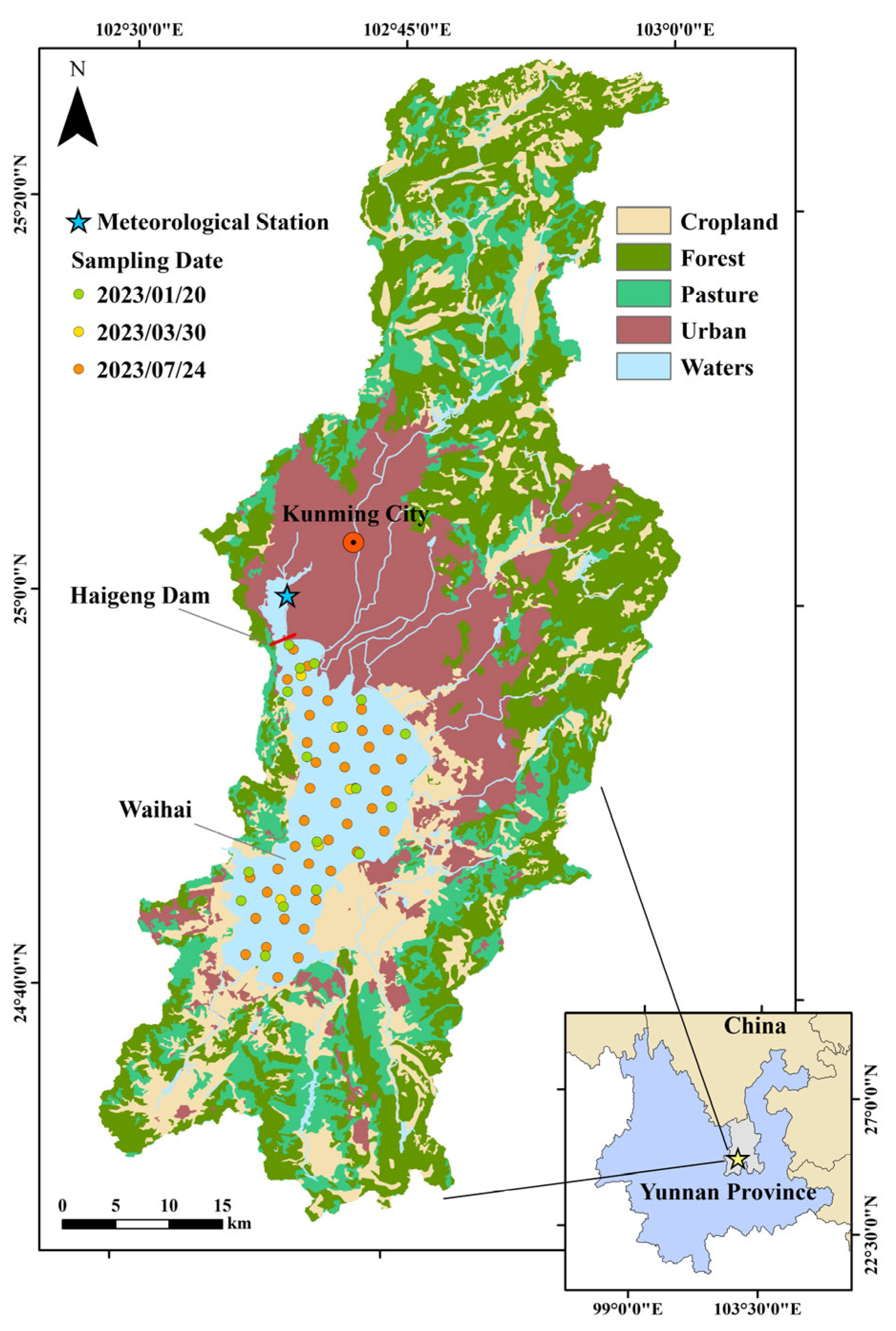

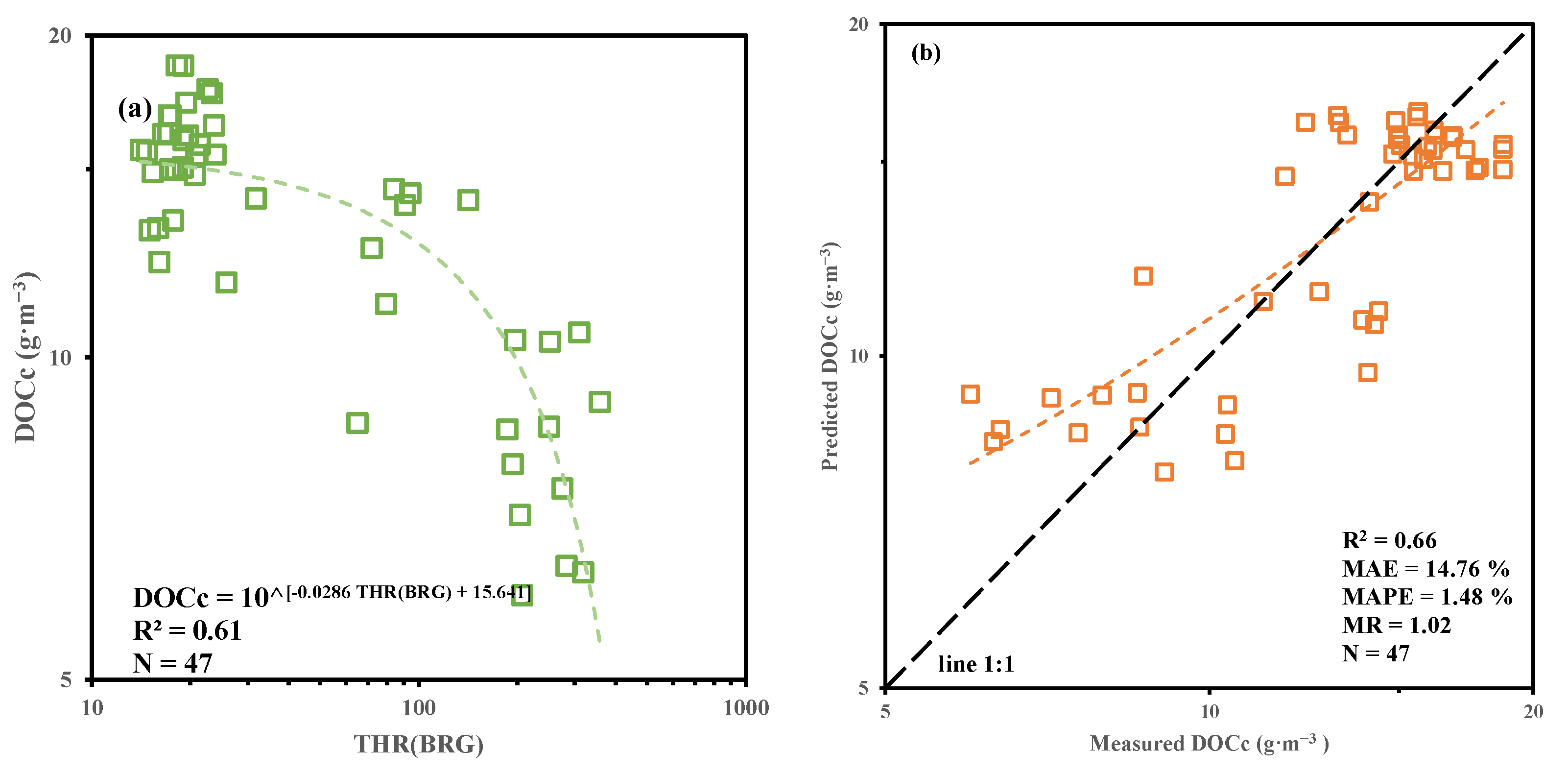
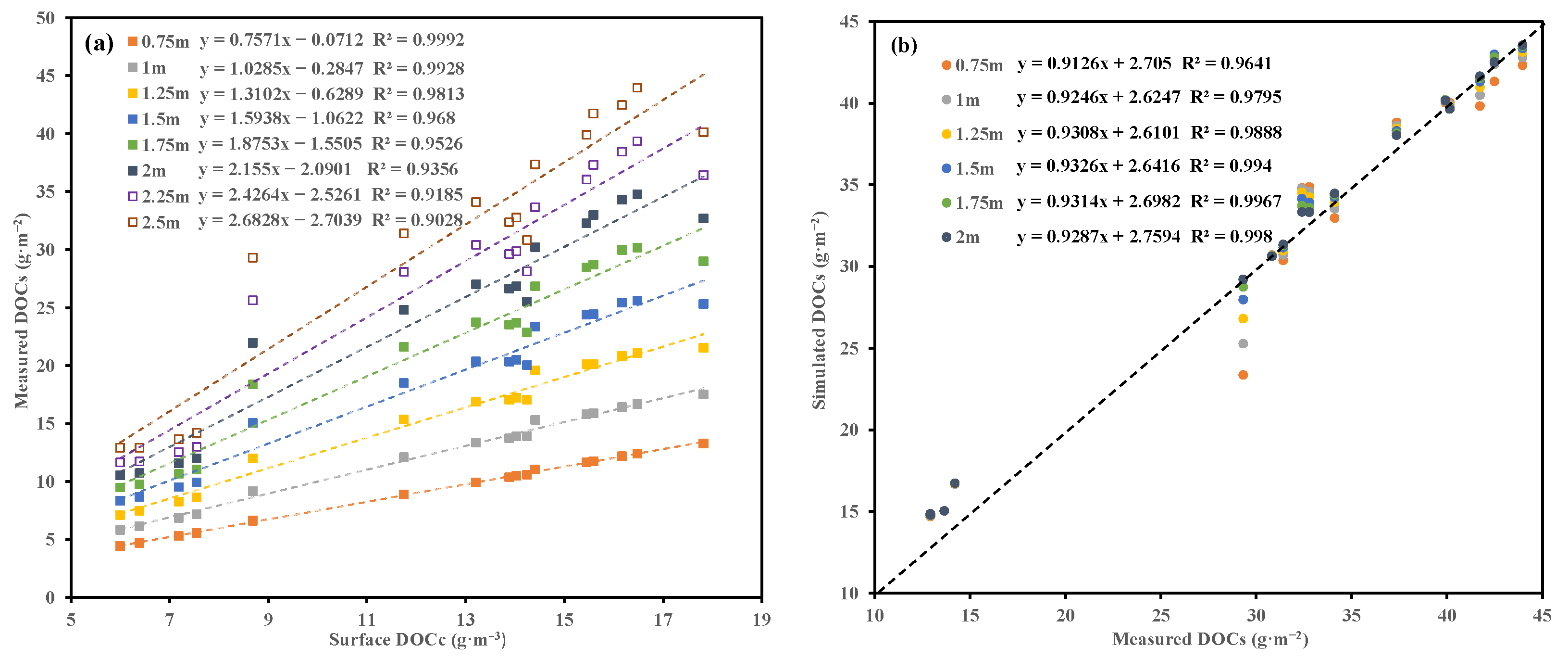
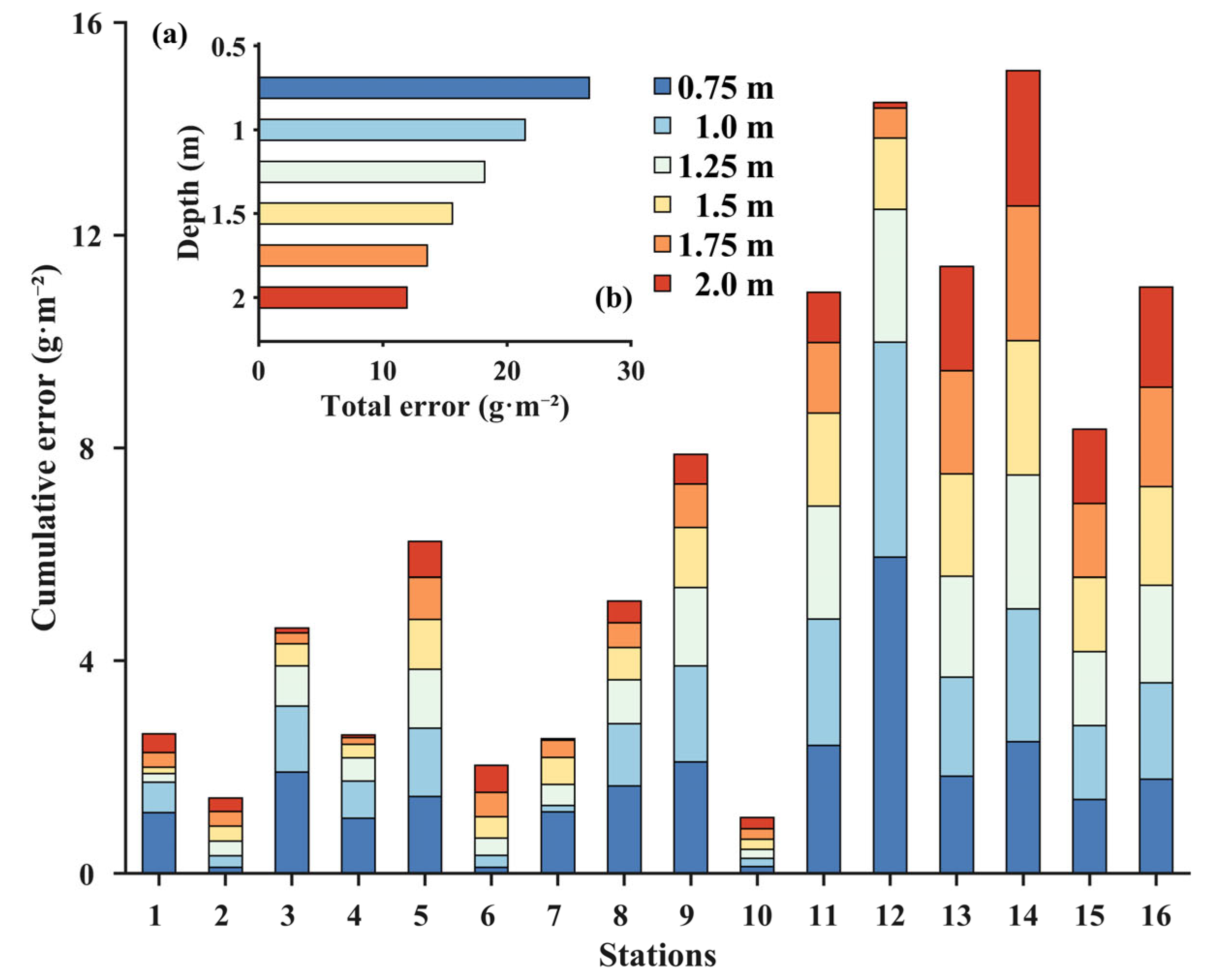
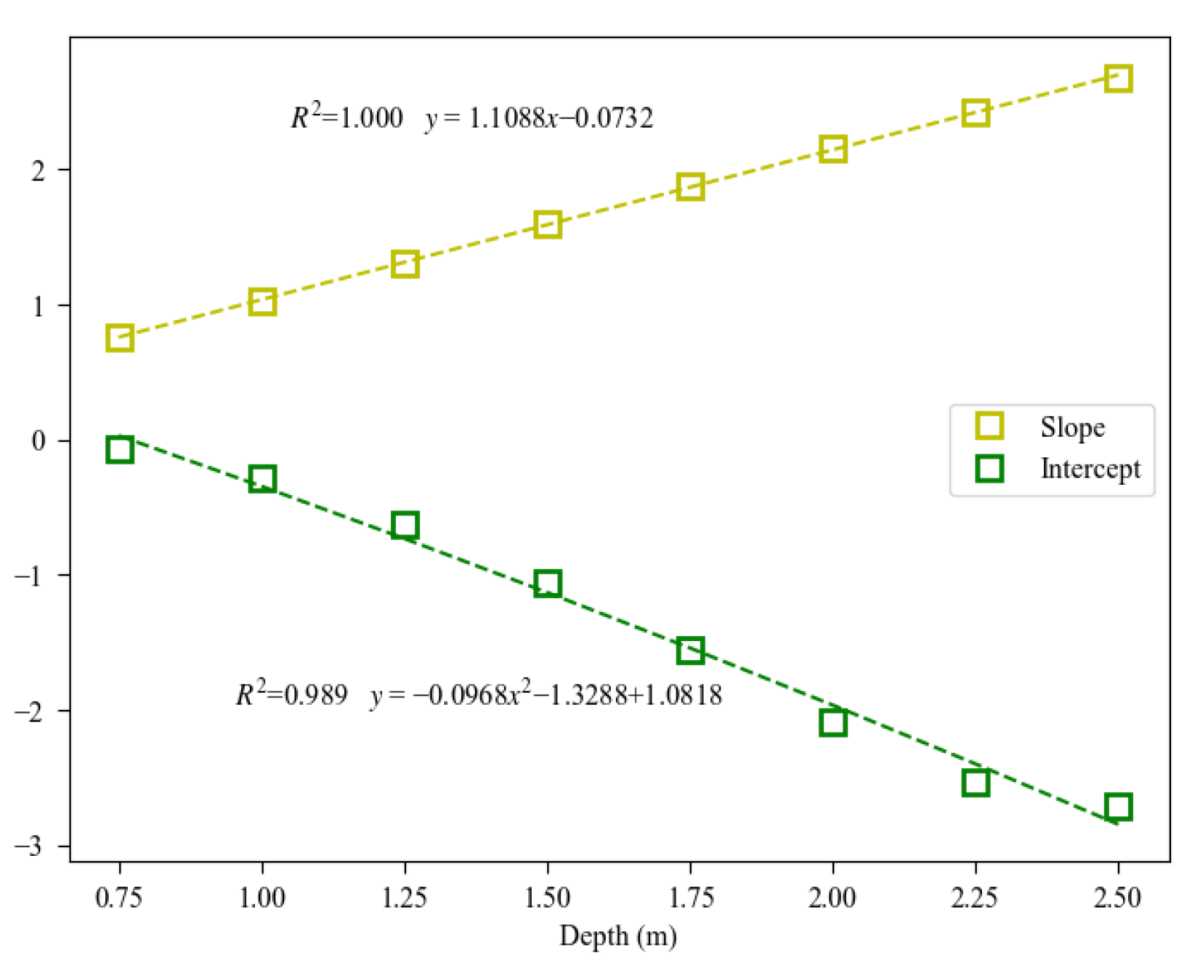

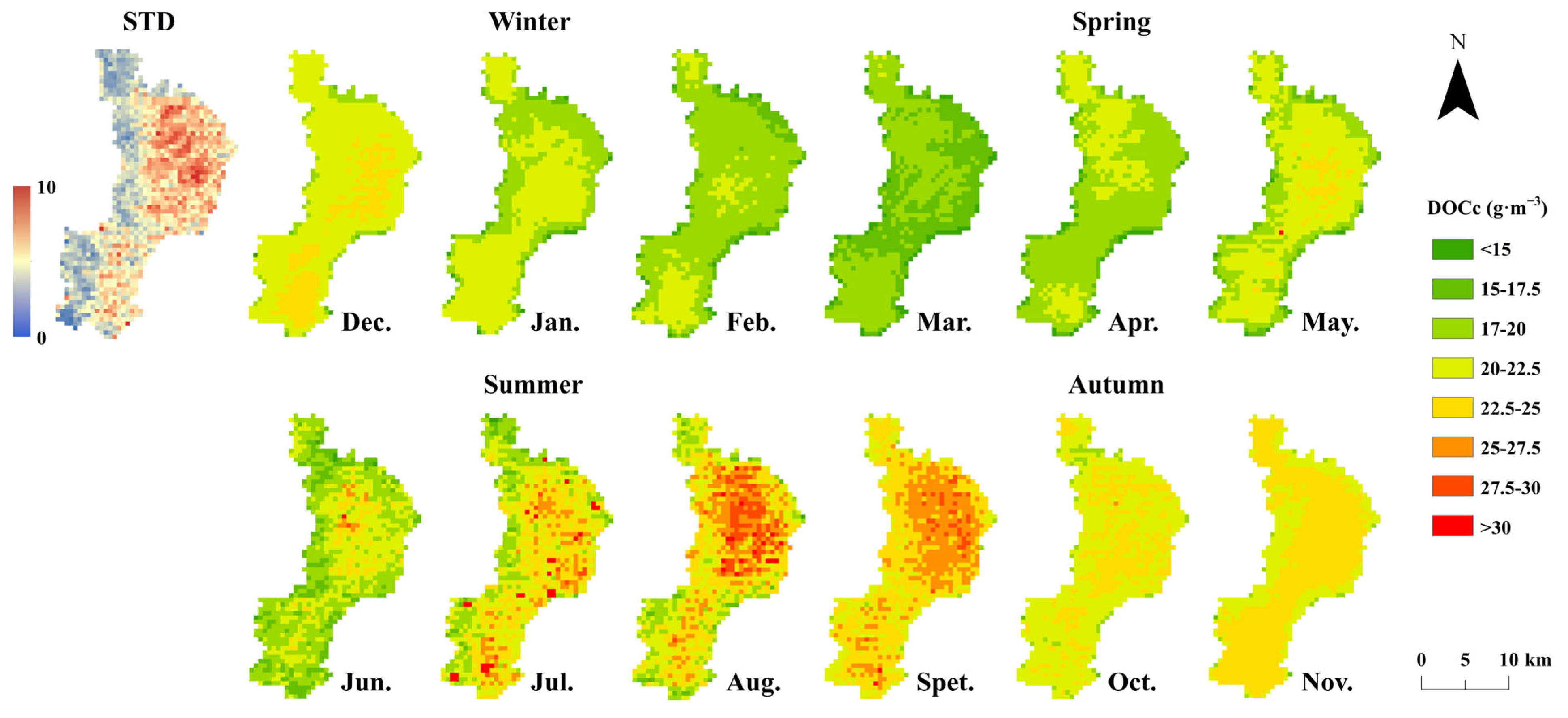
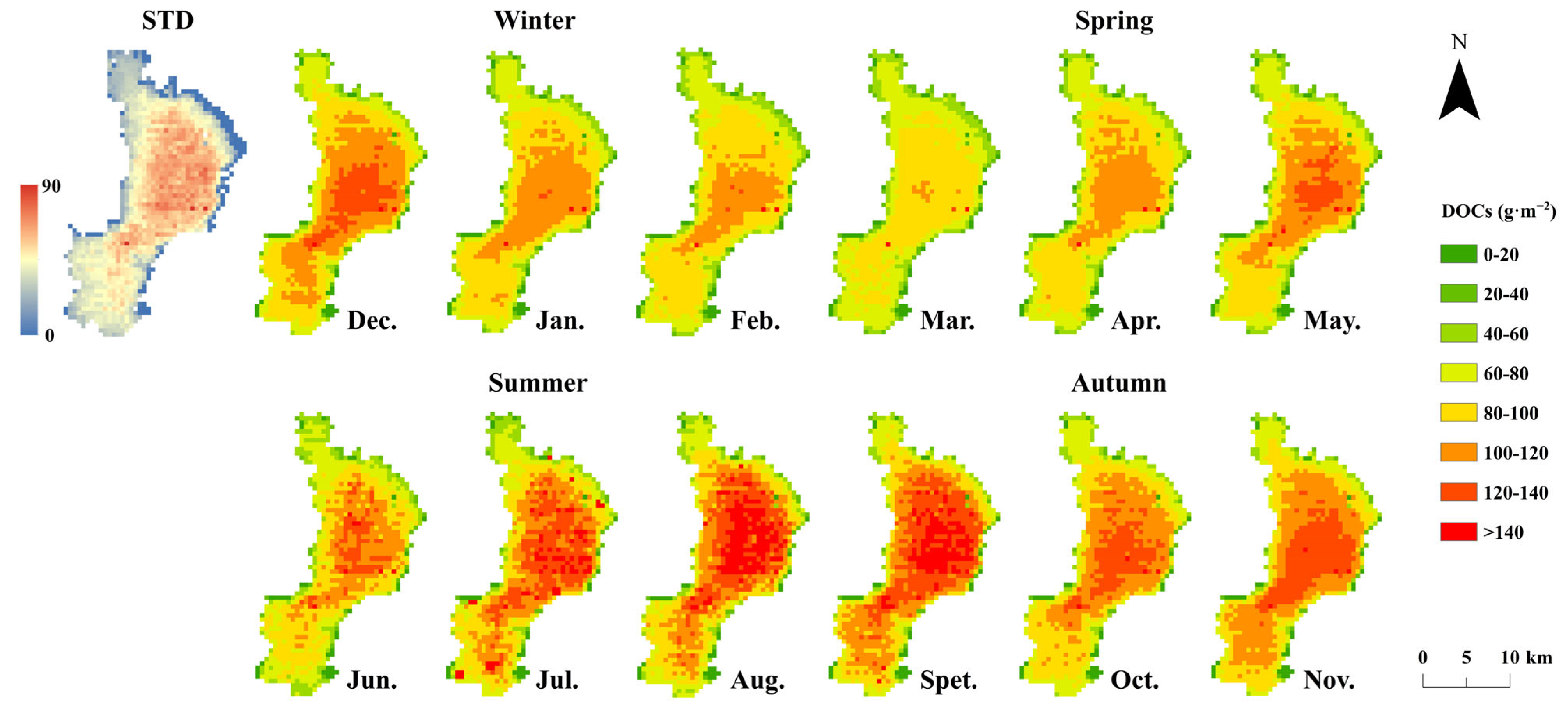


| Sampling Date (Number) | Min | Max | Mean | Std | CV |
|---|---|---|---|---|---|
| 20 January 2023 (12) | 3.99 | 11.02 | 8.14 | 1.89 | 23.30% |
| 30 March 2023 (5) | 8.69 | 14.24 | 12.41 | 2.16 | 17.44% |
| 24 July 2023 (30) | 11.75 | 18.75 | 15.42 | 1.71 | 11.00% |
| Name | Combination |
|---|---|
| TWO () | , , |
| THR () | |
| Time | Index | Min | Max | Mean | CV of Indices |
|---|---|---|---|---|---|
| Year | CV | 1.57% | 39.14% | 11.23% | 101.39% |
| MRD | 0.86 | 0.99 | 0.94 | 2.99% | |
| CP | 1.45 | 2.49 | 1.89 | 15.75% | |
| WCCD | 0.03 | 0.93 | 0.28 | 91.34% | |
| January | CV | 27.46% | 39.14% | 31.96% | 13.39% |
| MRD | 0.90 | 0.99 | 0.93 | 3.65% | |
| CP | 2.02 | 2.17 | 2.11 | 2.58% | |
| WCCD | 0.67 | 0.93 | 0.75 | 13.68% | |
| March | CV | 13.31% | 26.34% | 19.22% | 25.97% |
| MRD | 0.94 | 0.98 | 0.96 | 1.80% | |
| CP | 1.70 | 2.22 | 1.90 | 10.32% | |
| WCCD | 0.33 | 0.62 | 0.45 | 23.76% | |
| July | CV | 4.53% | 10.97% | 6.50% | 35.25% |
| MRD | 0.92 | 0.95 | 0.94 | 0.72% | |
| CP | 1.45 | 2.49 | 1.78 | 19.99% | |
| WCCD | 0.12 | 0.32 | 0.18 | 36.79% |
| Time | Range (g·m−2) | Mean | STD (g·m−2) | Trend (p < 0.05) |
|---|---|---|---|---|
| Spring | 60.0–97.4 | 79.3 | 9.2 | / |
| Summer | 62.5–105.2 | 86.2 | 11.9 | / |
| Autumn | 83.7–120.4 | 96.8 | 9.5 | increase |
| Winter | 55.0–126.4 | 83.9 | 15.3 | Increase |
| Year | 72.5–105.8 | 86.8 | 7.2 | / |
Disclaimer/Publisher’s Note: The statements, opinions and data contained in all publications are solely those of the individual author(s) and contributor(s) and not of MDPI and/or the editor(s). MDPI and/or the editor(s) disclaim responsibility for any injury to people or property resulting from any ideas, methods, instructions or products referred to in the content. |
© 2025 by the authors. Licensee MDPI, Basel, Switzerland. This article is an open access article distributed under the terms and conditions of the Creative Commons Attribution (CC BY) license (https://creativecommons.org/licenses/by/4.0/).
Share and Cite
Yang, Y.; Gao, W.; Zhang, Y. Retrieval of Dissolved Organic Carbon Storage in Plateau Lakes Based on Remote Sensing and Analysis of Driving Factors: A Case Study of Lake Dianchi. Remote Sens. 2025, 17, 1791. https://doi.org/10.3390/rs17101791
Yang Y, Gao W, Zhang Y. Retrieval of Dissolved Organic Carbon Storage in Plateau Lakes Based on Remote Sensing and Analysis of Driving Factors: A Case Study of Lake Dianchi. Remote Sensing. 2025; 17(10):1791. https://doi.org/10.3390/rs17101791
Chicago/Turabian StyleYang, Yufeng, Wei Gao, and Yuan Zhang. 2025. "Retrieval of Dissolved Organic Carbon Storage in Plateau Lakes Based on Remote Sensing and Analysis of Driving Factors: A Case Study of Lake Dianchi" Remote Sensing 17, no. 10: 1791. https://doi.org/10.3390/rs17101791
APA StyleYang, Y., Gao, W., & Zhang, Y. (2025). Retrieval of Dissolved Organic Carbon Storage in Plateau Lakes Based on Remote Sensing and Analysis of Driving Factors: A Case Study of Lake Dianchi. Remote Sensing, 17(10), 1791. https://doi.org/10.3390/rs17101791






